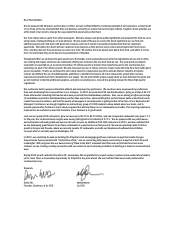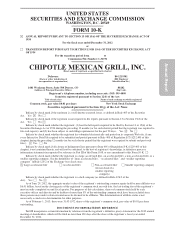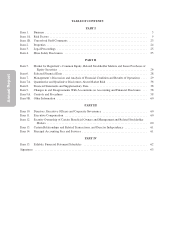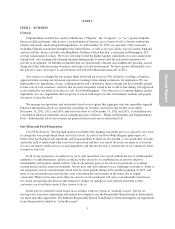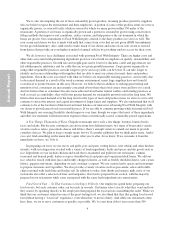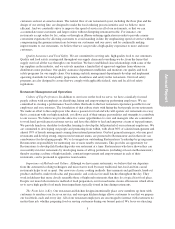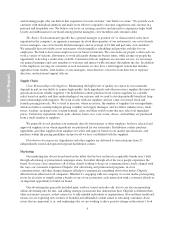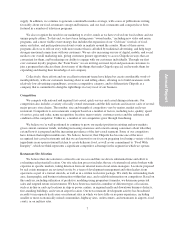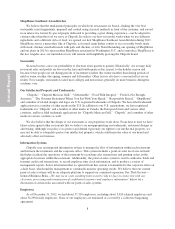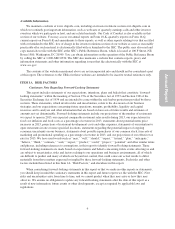Chipotle 2012 Annual Report Download - page 10
Download and view the complete annual report
Please find page 10 of the 2012 Chipotle annual report below. You can navigate through the pages in the report by either clicking on the pages listed below, or by using the keyword search tool below to find specific information within the annual report.
ShopHouse Southeast Asian Kitchen
We believe that the fundamental principles on which our restaurants are based—finding the very best
sustainably raised ingredients, prepared and cooked using classical methods in front of the customer, and served
in an interactive format by special people dedicated to providing a great dining experience—can be adapted to
cuisines other than the food we serve at Chipotle. In order to see how our model works when we use different
ingredients and a different style of food, we opened our first ShopHouse Southeast Asian Kitchen during 2011.
ShopHouse serves a menu that, like at Chipotle, is focused; main dishes consist of rice or noodle bowls made
with steak, chicken, meatballs made with pork and chicken, or tofu. Notwithstanding our opening of ShopHouse
and our plans in 2013 to open another ShopHouse restaurant in Washington, D.C. and to introduce ShopHouse to
the Los Angeles area, our immediate focus will remain on thoughtfully growing the Chipotle brand.
Seasonality
Seasonal factors cause our profitability to fluctuate from quarter to quarter. Historically, our average daily
restaurant sales and profits are lower in the first and fourth quarters due, in part, to the holiday season and
because fewer people eat out during periods of inclement weather (the winter months) than during periods of
mild or warm weather (the spring, summer and fall months). Other factors also have a seasonal effect on our
results. For example, restaurants located near colleges and universities generally do more business during the
academic year.
Our Intellectual Property and Trademarks
“Chipotle,” “Chipotle Mexican Grill,” “Unburritable,” “Food With Integrity,” “Fresh Is Not Enough,
Anymore,” “The Gourmet Restaurant Where You Eat With Your Hands,” “Responsibly Raised,” “ShopHouse”
and a number of related designs and logos are U.S. registered trademarks of Chipotle. We have filed trademark
applications for a number of other marks in the U.S. In addition to our U.S. registrations, we have registered
trademarks for “Chipotle” and a number of other marks in Canada, the European Union and various other
countries, and have filed trademark applications for “Chipotle Mexican Grill,” “Chipotle” and a number of other
marks in various countries as well.
We also believe that the design of our restaurants is our proprietary trade dress. From time to time we have
taken action against other restaurants that we believe are misappropriating our trademarks, restaurant designs or
advertising. Although our policy is to protect and defend vigorously our rights to our intellectual property, we
may not be able to adequately protect our intellectual property, which could harm the value of our brand and
adversely affect our business.
Information Systems
Chipotle uses an integrated information system to manage the flow of information within each restaurant
and between the restaurants and the corporate office. This system includes a point-of-sales local area network
that helps facilitate the operations of the restaurant by recording sales transactions and printing orders in the
appropriate locations within the restaurant. Additionally, the point-of-sales system is used to authorize, batch and
transmit credit card transactions, to record employee time clock information, and to produce a variety of
management reports. Select information that is captured from this system is transmitted to the corporate office on
a daily basis, which enables management to continually monitor operating results. We believe that our current
point-of-sales systems will be an adequate platform to support our continued expansion. See “Risk Factors—
General Business Risks—We may incur costs resulting from security risks we face in connection with our
electronic processing and transmission of confidential customer and employee information” below for a
discussion of certain risks associated with our point-of-sales systems.
Employees
As of December 31, 2012, we had about 37,310 employees, including about 3,020 salaried employees and
about 34,290 hourly employees. None of our employees are unionized or covered by a collective bargaining
agreement.
8
Annual Report


